
Dalmatia is a historical region on the eastern shore of the Adriatic Sea in Croatia, a narrow belt stretching from the island of Rab in the north to the Bay of Kotor in the south. The Dalmatian Hinterland ranges in width from fifty kilometres in the north, to just a few kilometres in the south; it is mostly covered by the rugged Dinaric Alps. Seventy-nine islands run parallel to the coast, the largest being Brač, Pag, and Hvar. The largest city is Split, followed by Zadar, Šibenik, and Dubrovnik.
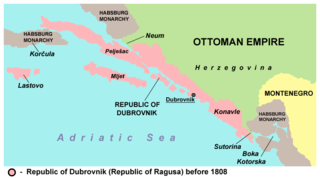
Dalmatian or Dalmatic was a Romance language that was spoken in the Dalmatia region of present-day Croatia, and as far south as Kotor in Montenegro. The name refers to a tribe of the Illyrian linguistic group, Dalmatae. The Ragusan dialect of Dalmatian, the most studied prestige dialect, was the official language of the Republic of Ragusa for much of its medieval history until it was gradually supplanted by other local languages.
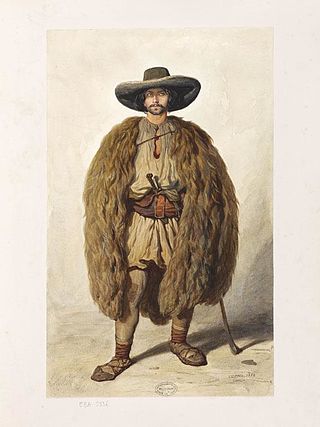
Vlach, also Wallachian, is a historical term and exonym used from the Middle Ages until the Modern Era to designate speakers of Eastern Romance languages living in the Balkans and north of the Danube.

The Military Frontier was a borderland of the Habsburg monarchy and later the Austrian and Austro-Hungarian Empire. It acted as the cordon sanitaire against incursions from the Ottoman Empire.

Morlachs has been an exonym used for a rural Christian community in Herzegovina, Lika and the Dalmatian Hinterland. The term was initially used for a bilingual Vlach pastoralist community in the mountains of Croatia from the second half of the 14th until the early 16th century. Then, when the community straddled the Venetian–Ottoman border until in the 17th century, it only referred to Slavic-speaking, mainly Eastern Orthodox but also Roman Catholic people. The Vlach i.e. Morlach population of Herzegovina and Dalmatian hinterland from the Venetian and Turkish side were of either Roman Catholic or Christian Orthodox faith. Venetian sources from 17th and 18th century make no distinction between Orthodox and Catholics, they refer to both groupings as Morlachs. The exonym ceased to be used in an ethnic sense by the end of the 18th century, and came to be viewed as derogatory, but has been renewed as a social or cultural anthropological subject. As the nation-building of the 19th century proceeded, the Vlach/Morlach population residing with the Croats and Serbs of the Dalmatian Hinterland espoused either a Serb or Croat ethnic identity, but preserved some common sociocultural outlines.

The Uskoks were irregular soldiers in Habsburg Croatia that inhabited areas on the eastern Adriatic coast and surrounding territories during the Ottoman wars in Europe. Bands of Uskoks fought a guerrilla war against the Ottomans, and they formed small units and rowed swift boats. Since the uskoks were checked on land and were rarely paid their annual subsidy, they resorted to acts of piracy.
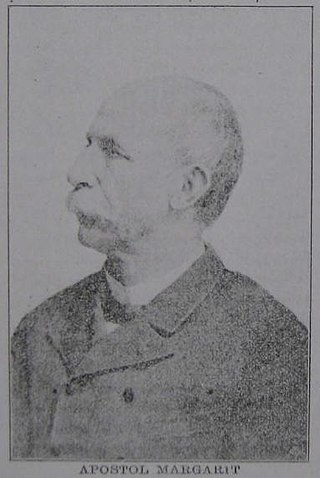
Apostol Mărgărit or Apostolos Margaritis was an Aromanian school teacher and writer. One of the most important voices of Aromanian emancipation in the 19th century, he conditioned Romania's policy toward the Aromanians, who started to have their own schools in their own language, thanks to Mărgărit's efforts.

The Istro-Romanians are a Romance ethnic group native to or associated with the Istrian Peninsula. Historically, they inhabited vast parts of it, as well as the western side of the island of Krk until 1875. However, due to several factors such as the industrialization and modernization of Istria during the socialist regime of Yugoslavia, many Istro-Romanians emigrated to other places, be them Croatian cities such as Pula and Rijeka or places such as New York City, Trieste and Western Australia. The Istro-Romanians dwindled severely in number, being reduced to eight settlements on the Croatian side of Istria in which they do not represent the majority.

Hasanaginica, also Asanaginica, is a South Slavic folk ballad, created during the period of 1646–49, in the region of Imotski, which at the time was a part of the Bosnia Eyalet of the Ottoman Empire.

Alberto Fortis (1741–1803) was an Italian writer, naturalist and cartographer, citizen of Republic of Venice.

Italians of Croatia are an autochthonous historical national minority recognized by the Constitution of Croatia. As such, they elect a special representative to the Croatian Parliament. There is Italian Union of Croatia and Slovenia, in Croat Talijanska Unija, in Slovene Italijanska Unija, which is Croat-Slovene organization with main site in Fiume-Rijeka and secondary site in Capodistria-Koper of Slovenia.
The term Vlachs was initially used in medieval Croatian and Venetian history for a Romance-speaking pastoralist community, called "Vlachs" and "Morlachs", inhabiting the mountains and lands of the Croatian Kingdom and the Republic of Venice from the early 14th century. By the end of the 15th century they were highly assimilated with the Slavs and lost their language or were at least bilingual, while some communities managed to preserve and continue to speak their language (Istro-Romanians).
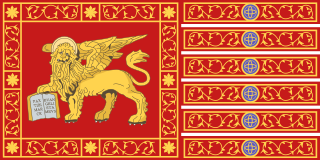
Venetian Dalmatia refers to parts of Dalmatia under the rule of the Republic of Venice, mainly from the 15th to the 18th centuries. Dalmatia was first sold to Venice in 1409 but Venetian Dalmatia was not fully consolidated from 1420. It lasted until 1797, when the Republic of Venice fell to the forces of Napoleon Bonaparte and Habsburg Austria.
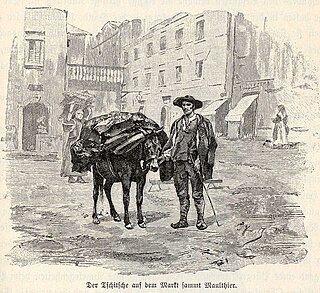
Ćić, is an ethnonym and exonym in a broader sense for all the people who live in the mountainous Ćićarija area in Croatia and Slovenia. Alongside the term Ćiribirci, in the narrow sense, it is an exonym referring to a community of the Istro-Romanians in the village Žejane in a small part of eastern Ćićarija and the villages around the former Lake Čepić west of the Učka range in Istria, Croatia.

Dalmatian city-states were the Dalmatian localities where the local Romance population survived the Barbarian invasions after the fall of the Western Roman Empire in the 400s CE. Eight little cities were created by those autochthonous inhabitants that maintained political links with the Eastern Roman Empire. The original names of these cities were Jadera, Spalatum, Crespa, Arba, Tragurium, Vecla, Ragusium, and Cattarum. The language and the laws were initially Latin, but after a few centuries, they developed their own Neo-Latin language, Dalmatico, which lasted until the 19th century. The cities were maritime centres with huge commerce, mainly with the Italian peninsula and with the growing Republic of Venice.
The Morlach troops was an irregular military group in the Dalmatian hinterland, composed of Morlachs, that was hired by the Republic of Venice to fight the Ottoman Empire during the Cretan War (1645–69) and the Great Turkish War (1683–99).
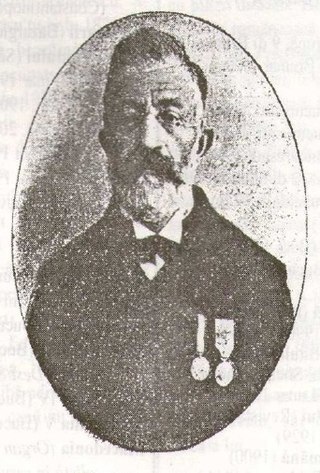
Dimitri Atanasescu Hagi Sterjio was an Aromanian tailor and later teacher known for having been the teacher of the first Romanian school in the Balkans for the Aromanians, located at Trnovo, the place where he was born, which was then part of the Ottoman Empire.
The Aromanian diaspora is any ethnically Aromanian population living outside its traditional homeland in the Balkans. The Aromanians are a small Balkan ethnic group living scattered throughout Albania, Bulgaria, Greece, North Macedonia, Romania and Serbia. Historically, they also used to live in other countries such as Bosnia and Herzegovina and Croatia, although they have ever since been assimilated.
Katun is the name for the form of medieval self-governing community in the Balkans. It is very similar to a Turkish: cemaât, Arabic: جماعة, romanized: jamaat, lit. 'congregation'. This form of association of people is a consequence of the absence of strong central government, and is observed in documents from the second half of the 14th and 15th centuries. It is often associated with a living style of "Vlachs" in Bosnia and Herzegovina, Croatia, Montenegro and Serbia, as well as some Albanian and Slavic communities of hill people.
Alvise Badoer was a Venetian patrician, lawyer, administrator and diplomat. He played a major role in the Ottoman–Venetian War of 1537–1540. He advocated for and helped arrange the Holy League in 1537–1538, took command of Venetian Dalmatia in 1538–1539 and negotiated the peace treaty in 1540.
















